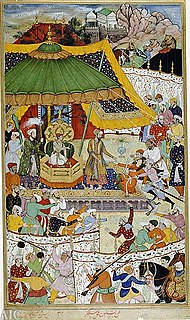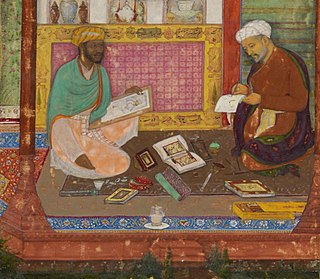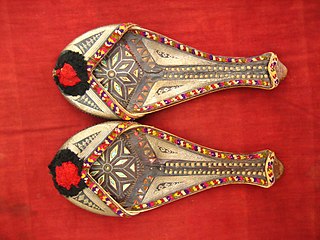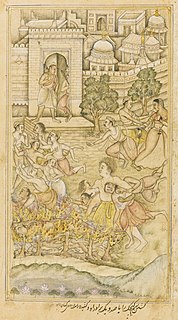 W
WThe Ain-i-Akbari or the "Administration of Akbar", is a 16th-century detailed document recording the administration of the Mughal Empire under Emperor Akbar, written by his court historian, Abu'l Fazl in the Persian language. It forms Volume III and the final part of the much larger document, the Akbarnama, also by Abu'l-Fazl, and is itself in three volumes.
 W
WThe Akbarnama, which translates to Book of Akbar, is the official chronicle of the reign of Akbar, the third Mughal Emperor, commissioned by Akbar himself by his court historian and biographer, Abu'l-Fazl ibn Mubarak, called one of the "nine jewels in Akbar's court" by Mughal writers. It was written in Persian, which is the literary language of the Mughals, and includes vivid and detailed descriptions of his life and times. It followed the Baburnama, the more personal memoir by his grandfather, Babur, founder of the dynasty. Like that, it was produced in the form of lavishly illustrated manuscripts.
 W
WThe Bāburnāma is the memoirs of Ẓahīr-ud-Dīn Muhammad Bābur (1483–1530), founder of the Mughal Empire and a great-great-great-grandson of Timur. It is written in the Chagatai language, known to Babur as "Turki", the spoken language of the Andijan-Timurids. During Emperor Akbar's reign, the work was completely translated to Persian, the usual literary language of the Mughal court, by a Mughal courtier, Abdul Rahīm, in AH 998 (1589–90). Translations into many other languages followed, mostly from the 19th century onwards.
 W
WThe Crown of the Bahadur Shah II is the head dress of last Mughal emperor Bahadur Shah II.
 W
WDelhi Book or Delhie Book titled Reminiscences of Imperial Delhi is a collection of paintings done in company style, commissioned by Sir Thomas Metcalfe in 1844. It contains 120 paintings by Indian artists, mainly by Mughal painter, Mazhar Ali Khan. The book was bought by the British Library and displayed in London.
 W
WThe Fraser Album is a collection of paintings commissioned by British Indian civil servant, William Fraser. It is considered among the greatest masterpieces of Indian art. This work is an important documentation of the Mughal empire towards its end.
 W
WThe Hamzanama or Dastan-e-Amir Hamza narrates the legendary exploits of Amir Hamza, or Hamza ibn Abdul-Muttalib, an uncle of Muhammad who was a historical figure, though most of the stories are extremely fanciful, "a continuous series of romantic interludes, threatening events, narrow escapes, and violent acts". The Hamzanama chronicles the fantastic adventures of Hamza as he and his band of heroes fight against the enemies of Islam. The stories, from a long-established oral tradition, were written down in Persian, the language of the courts of the Persianate world, in multiple volumes presumably in the era of Mahmud of Ghazni. In the West the work is best known for the enormous illustrated manuscript commissioned by the Mughal Emperor Akbar in about 1562. The text augmented the story, as traditionally told in dastan performances. The dastan about Amir Hamza persists far and wide up to Bengal and Arakan (Burma), as the Mughals controlled those territories. The longest version of the Hamzanama exists in Urdu and contains 46 volumes in approximately over 45,000 pages.
 W
W"Hasht-Bihisht" is a famous poem written by Amir Khusrow around 1302 AD. The poem is based on the Haft Paykar by Nizami, written around 1197 AD, which in turn takes its outline from the earlier epic Shahnameh written by Firdausi around 1010 AD. Like Nizami's Haft Paykar, Khusro's Hasht Bihisht uses a legend about Bahram V Gur as its frame story and, in the style of One Thousand and One Nights, introduces folktales told by seven princesses. Most famously, Khusro appears to be the first writer to have added The Three Princes of Serendip as characters and the story of the alleged camel theft and recovery.
 W
WThe Jade Terrapin from Allahabad is a large sculpture of a terrapin carved from a single piece of jade. Dating from the early 17th Century when most of India was ruled by the Mughal dynasty, this luxurious and unique artefect was found in Allahabad in the early nineteenth century.
 W
WThe illuminated manuscript Khamsa of Nizami British Library, Or. 12208 is a lavishly illustrated manuscript of the Khamsa or "five poems" of Nizami Ganjavi, a 12th-century Persian poet, which was created for the Mughal Emperor Akbar in the early 1590s by a number of artists and a single scribe working at the Mughal court, very probably in Akbar's new capital of Lahore in North India, now in Pakistan. Apart from the fine calligraphy of the Persian text, the manuscript is celebrated for over forty Mughal miniatures of the highest quality throughout the text; five of these are detached from the main manuscript and are in the Walters Art Museum, Baltimore as Walters Art Museum MS W.613. The manuscript has been described as "one of the finest examples of the Indo-Muslim arts of the book", and "one of the most perfect of the de luxe type of manuscripts made for Akbar".
 W
WMojari or Khussa or Saleem Shahi's is a style of handcrafted footwear produced in South Asia. They are traditionally made by artisans mostly using tanned leather. The uppers are made of one piece of leather or textile embroidered and embellished with brass nails, cowry shells, mirrors, bells and ceramic beads. Even the bonding from the upper to the sole is done by cotton thread that is not only eco-friendly but also enmeshes the leather fibers with great strength. Some product range also uses bright and ornate threads.
 W
WMughal clothing refers to clothing developed by the Mughals in the 16th, 17th and 18th centuries throughout the extent of their empire in the Indian subcontinent. It was characterized by luxurious styles and was made with muslin, silk, velvet and brocade. Elaborate patterns including dots, checks, and waves were used with colors from various dyes including cochineal, sulfate of iron, sulfate of copper and sulfate of antimony were used.
 W
WMughal painting is a particular style of South Asian, particularly North Indian, painting confined to miniatures either as book illustrations or as single works to be kept in albums (muraqqa). It emerged from Persian miniature painting and developed in the court of the Mughal Empire of the 16th to 18th centuries. The Mughal emperors were Muslims and they are credited with consolidating Islam in South Asia, and spreading Muslim arts and culture as well as the faith.
 W
WKhussa, is a style of South Asian handcrafted footwear produced in Punjab Pakistan.
 W
WA Muraqqa is an album in book form containing Islamic miniature paintings and specimens of Islamic calligraphy, normally from several different sources, and perhaps other matter. The album was popular among collectors in the Islamic world, and by the later 16th century became the predominant format for miniature painting in the Persian Safavid, Mughal and Ottoman empires, greatly affecting the direction taken by the painting traditions of the Persian miniature, Ottoman miniature and Mughal miniature. The album largely replaced the full-scale illustrated manuscript of classics of Persian poetry, which had been the typical vehicle for the finest miniature painters up to that time. The great cost and delay of commissioning a top-quality example of such a work essentially restricted them to the ruler and a handful of other great figures, who usually had to maintain a whole workshop of calligraphers, artists and other craftsmen, with a librarian to manage the whole process.
 W
WPadshahnama or Badshah Nama is a genre of works written as the official history of the Mughal Emperor, Shah Jahan’s reign. Unillustrated texts are known as Shahjahannama, with Padshahnama used for the illustrated manuscript versions. These works are among the major sources of information about Shah Jahan's reign. Lavishly illustrated copies were produced in the imperial workshops, with many Mughal miniatures. Although military campaigns are given the most prominence, the illustrations and paintings in the manuscripts of these works illuminate life in the imperial court, depicting weddings and other activities.
 W
WThe Peacock Throne was a famous jewelled throne that was the seat of the Mughal emperors of India. It was commissioned in the early 17th century by emperor Shah Jahan and was located in the Diwan-i-Khas in the Red Fort of Delhi. During the invasion of 1739, Nader Shah, the emperor of Iran, looted the precious jewels attached to it. In 1783, Sikh Sardars Baghel Singh, Jassa Singh Ahluwalia and Jassa Singh Ramgarhia conquered Delhi and hoisted the Nishan Sahib on the Red Fort. He came to the throne on horseback in protest of the persecution of the Sikhs, it was dragged to the Golden Temple, Amritsar. Where it is still present in the Ramgarhia Bunga. It was named after a peacock as two peacocks are shown dancing at its rear.
 W
WThe Razmnāma is a Persian translation of the Hindu epic poem Mahabharata, commissioned by the Mughal Emperor Akbar. In 1574, Akbar started an Maktab Khana or a house of translation works in his new capital of Fatehpur Sikri. He assigned the work to a few officials to translate the Sanskrit books Rajatarangini, Ramayana and Mahabharata into the Persian language, the literary language of the Mughal court.
 W
WThe Razmnama, British Library Or.12076 is an incomplete illustrated Mughal manuscript of the Razmnama, which is a translation of the Hindu epic Mahabharata written by Naqib Khan, and copied in AH 1007 (1598/99). It contains sections 14–18, the concluding part of the work, with some detached parts. There are 24 full-page Mughal paintings of high quality, all attributed to artists. It is the second of the four surviving Mughal illustrated manuscripts, described in the BL catalogue as "Sub-imperial Mughal".
 W
WIn his late career in the 1650s, the Dutch artist Rembrandt created drawings that were inspired by miniatures from Mughal India. This was the only time the artist engaged with the artistic style of a "dramatically foreign culture". They depict Mughal emperors, noblemen, courtiers, and sometimes women and common folk. They were executed on expensive Asian or Japanese paper, and only 23 drawings survive today.
 W
WSarpech also known as an aigrette is a turban ornament that was worn by significant Hindu, Sikh and Muslim princes. Sar means head or front and pech means screw. Hence, the word Sarpech literally means that which is screwed onto the front. It was also worn in Persia where it was known as jikka or jiqa which means crest or tuft and in Turkey it was known as Sorguch which is considered a corrupt form of the Persian word sarpush. In India, dominantly two kinds of turban ornaments exist: Sarpech and Kalgi (ornament).
 W
WThewa is a special art of jewelry making which involves fusing of intricately worked-out sheet gold on molten glass. It evolved in Pratapgarh district, Rajasthan India. Its origin dates back to the Mughal age.
 W
WTutinama, literal meaning "Tales of a Parrot", is a 14th-century Persian series of 52 stories. The work remains well-known largely because of a number of lavishly illustrated manuscripts, especially a version containing 250 miniature paintings was commissioned by the Mughal Emperor, Akbar in the 1550s. The Persian text used was redacted in 14th century AD in Iran from an earlier anthology ‘Seventy Tales of the Parrot’ in Sanskrit compiled under the title Śukasaptati dated to the 12th century AD. In Iran, as in India, parrots are popular as storytellers in works of fiction.
 W
WTuzuk-e-Jahangiri or Tuzuk-i-Jahangiri is the autobiography of Mughal Emperor Nur-ud-din Muhammad Jahangir (1569–1627). Also referred to as Jahangirnama, Tuzk-e-Jahangiri is written in Persian, and follows the tradition of his great-grandfather, Babur (1487–1530), who had written the Baburnama; though Jahangir went a step further and besides the history of his reign, he includes details like his reflections on art, politics, and also information about his family.
 W
WUmar Defeats a Dragon is a page from a Mughal Illuminated manuscript illustrating an episode from the Hamzanama. The page size is 55 x 70 cm. It is in the collection of the Museum of Applied Arts, Vienna, Vienna.
 W
WThe wine cup of Shah Jahan is a wine cup of white nephrite jade that was made for the Mughal emperor Shah Jahan.